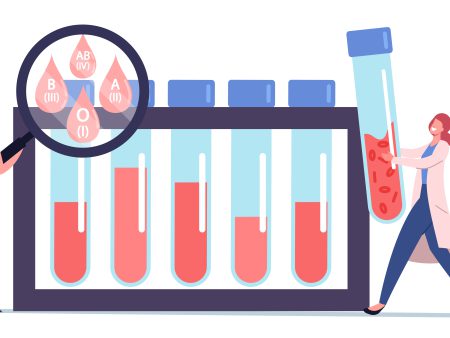
This article will look at the various facets of the paternity test, starting with the basics. He will then analyze the sampling process, before explaining how to decipher and understand the results. Reliability and limitations will also be discussed, as will the use of DNA testing in legal proceedings. In addition, some cases will be examined, as well as other tests relevant to this specific field of genetics.
The fundamentals
Have you ever considered the scientific accuracy behind a paternity test? This is essential for those seeking information about their genetic lineage.
A paternity test is a genetic analysis performed to determine the parent-child relationship between two individuals. It works by comparing the DNA profiles – each person’s unique biological signature – of the two parties. Mouth swabs are the most used, but blood or other body tissues can also be used.
Each child receives half its DNA from the father and half from the mother. By examining specific markers in the DNA samples of the alleged father and child, we can determine whether there is a match.
It’s important to stress that a positive test not only establishes biological paternity, but also potentially legal paternity. This outcome can have important legal consequences, for example in family law matters such as child custody or alimony payments.
These foundations not only shed light on family mysteries, but also help us to make decisions based on this valuable scientific knowledge.
Sampling
Sampling is a decisive step in the paternity testing process. It involves collecting a biological sample, which is then analyzed in a laboratory to identify the genetic profiles of the individuals concerned.
- Buccal sampling: This non-invasive technique involves rubbing the inside of the cheek with a sterile cotton swab to obtain epithelial cells.
- Blood sampling: Although less frequent, this method is highly accurate and can be performed on newborns via the umbilical cord.
- Tissue or body fluid samples: In certain situations, hair, urine or even saliva samples can be taken.
- Post-mortem sampling: In the event of the presumed death of the father, it is possible to use preserved tissue as a source of DNA.
- Fetuses and newborns: Tests can be carried out during pregnancy by sampling amniotic fluid or chorionic villi. After birth, umbilical cord blood can be used.
It must be stressed, however, that all these samples must be taken under medical supervision, to avoid any contamination that could falsify the results.
Deciphering the results
Understanding genetics
In a paternity test, the genetic examination focuses on specific DNA sequences called markers. These are inherited from parents and can vary between unrelated individuals. When two samples show a notable concordance in these markers, a biological link can be strongly assumed.
Read the report
Paternity test results are often expressed in terms of a paternity index or PI. A PI exceeding 100 suggests a high probability that the sample comes from the presumed father. It is crucial to study all the elements provided in the report in detail to fully understand its consequences.
Reliability and limitations
The reliability of a paternity test depends on the precision of the techniques used to analyze genetic profiles. Their reliability exceeds 99%. However, certain limitations remain. For example, monozygotic twins with identical DNA pose a problem: a standard test does not differentiate the biological father. In addition, rare genetic mutations can influence the accuracy of the result. It is therefore essential that these analyses are carried out in a certified laboratory and that genetic specialists deduce the conclusions to ensure their validity.
DNA testing in court
When it comes to legal issues, the use of paternity tests is tricky. Subject to strict guidelines, these tests are designed to protect individual rights and maintain social peace. In France, the unanimous agreement of the parties concerned is imperative, and carrying out a test without authorization is punishable by law.
Specific legal situations, such as disputes over parentage or family law, may lead a judge to order a DNA test to establish a biological connection. Nevertheless, several nations, including some members of the European Union, do not systematically accept this method, in the name of respect for the right to privacy.
Despite their scientific accuracy and their ability to elucidate complex family relationships, it remains essential to assess the legal and ethical consequences before considering the use of a DNA test from a legal perspective.
Special cases
Non-biological paternity
It’s important to note that paternity is not restricted to a biological connection. In certain situations, a male individual can be considered the sire of a child without having a direct hereditary link. This situation can be observed in various contexts:
- Official adoption of the child
- Paternity defined by contractual agreement (as with a sperm supplier)
- Voluntary recognition of paternal status
- Presumed paternity due to marital relationship with mother at time of conception or birth
- Judicial establishment of paternal link after contestation.
Maternity test
In addition to genetic testing to establish paternal relationship, tests to establish maternity are also feasible and reliable. They are based on the same premise as traditional DNA tests: comparing hereditary profiles to identify whether two people share a mother-child relationship. These examinations can be useful in a variety of circumstances, such as an adoption abroad, a medically assisted procreation process, or when there are uncertainties concerning childbirth.
Other relevant tests
Home DNA kits
In genetics, home DNA kits are a major step forward. They allow anyone to carry out a genetic test at home. These kits are simple and convenient, requiring just a sample of saliva or a buccal cell for analysis. However, it is important to emphasize that these tests are not legally recognized due to the potential lack of sample integrity, and therefore cannot be used as evidence in legal disputes.
The fraternity DNA test
In addition to the usual paternal tests, DNA fraternity testing is relevant in certain specific situations. It is used to check whether two individuals have a parent in common. This type of test can be useful when the presumed father is no longer around to provide his DNA, or simply refuses to participate. The analysis is carried out on specific markers in the DNA of the two people concerned, to establish a statistical probability of the sibling link between them.
Tracing origins
Thanks to scientific advances in genetics, it is now possible to trace one’s ancestral origins through DNA tracing with precision and accuracy. This type of test examines several hundred or thousand genetic markers to give a global picture of an individual’s ancestral past. It offers the chance to find distant ancestors, reveal hitherto unknown family links and understand the complexity of the genetic make-up of each individual.












